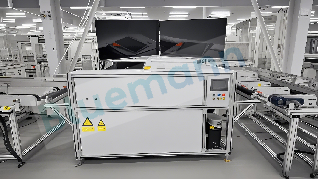The photovoltaic (PV) industry has seen rapid growth in recent years, driven by the increasing demand for renewable energy sources. With this growth comes the need for efficient and reliable testing methods to ensure the quality of PV modules. Among these methods, Electroluminescence (EL) and Visual Inspection (VI) test machines have emerged as crucial tools in the quality control process.

Overview of EL and VI Test Machines
Bluemann EL and VI test machines are advanced inspection systems designed to detect defects in PV modules. They combine automation and cutting-edge technology to provide a comprehensive analysis of module integrity. The integration of these machines in PV manufacturing processes has revolutionized quality control, enhancing efficiency and accuracy.
Automated Defect Detection
Core Functionality of EL and VI Test Machines
EL and VI test machine can automatically judge defects related to photovoltaic modules. This automation is a game-changer in the industry, as it significantly reduces human error and enhances the consistency of inspection results. Here’s a closer look at how these machines operate:
Electroluminescence (EL) Testing: EL testing involves applying a high voltage to the PV module in a dark environment. Defective areas, such as cracks, shunts, or broken cells, emit light differently from healthy cells, allowing for easy identification. The EL test machine captures these emissions through high-resolution cameras and processes the images to highlight defects.
Visual Inspection (VI) Testing: VI testing complements EL testing by providing a visual examination of the module's exterior. The machine uses advanced cameras and visual recognition software to detect issues such as dirt, scratches, or other physical imperfections that may affect performance. VI testing ensures that only aesthetically pleasing and fully functional modules reach the market.
Advantages of Automation Over Manual Inspection
Labor Cost Savings
One of the most immediate benefits of EL and VI test machines is the reduction in labor costs. Traditional manual inspection is time-consuming and requires skilled inspectors to meticulously examine each module. Automation eliminates the need for extensive manual labor, thus lowering operational costs.
Mitigating Human Error
Manual inspection is prone to human error, especially when inspectors experience visual fatigue. EL and VI test machines, however, operate consistently without the limitations of human perception. They can detect defects with high precision, ensuring that no flaws are overlooked.
Consistency and Reliability
Automated testing provides consistent results, making it easier to maintain quality standards across different batches of PV modules. This consistency is crucial for meeting industry regulations and customer expectations.
Role in Quality Control
Enhancing Manufacturing Efficiency
In the competitive PV industry, manufacturers must balance cost, quality, and production speed. EL and VI test machines enable them to do just that. By automating the inspection process, these machines reduce inspection time, allowing manufacturers to increase throughput without compromising on quality.
Ensuring Compliance with Standards
PV modules must adhere to stringent international standards to ensure safety and performance. EL and VI test machines play a vital role in verifying compliance by providing detailed reports on module condition. These reports are invaluable for demonstrating adherence to regulations and gaining customer trust.
Driving Innovation
As technology advances, so too must the methods used to test PV modules. EL and VI test machines are continually being upgraded with new features and capabilities, driving innovation in the PV industry. Manufacturers that embrace these advancements can stay ahead of the competition by offering superior products.
In conclusion, EL and VI test machines are indispensable tools in the photovoltaic industry. Their ability to automatically judge defects related to PV modules, combined with the advantages of automation over manual inspection, makes them crucial for quality control. By enhancing manufacturing efficiency, ensuring compliance with standards, and driving innovation, these machines are playing a pivotal role in the growth and development of the PV industry. As technology continues to evolve, the importance of Bluemann EL and VI test machines will only increase, solidifying their place as essential components in the production of high-quality PV modules.
https://www.bluemannsolar.com/application-of-el-and-vi-test-machine-in-photovoltaic-industry.html
www.bluemannsolar.com
Wuxi Bluemann

